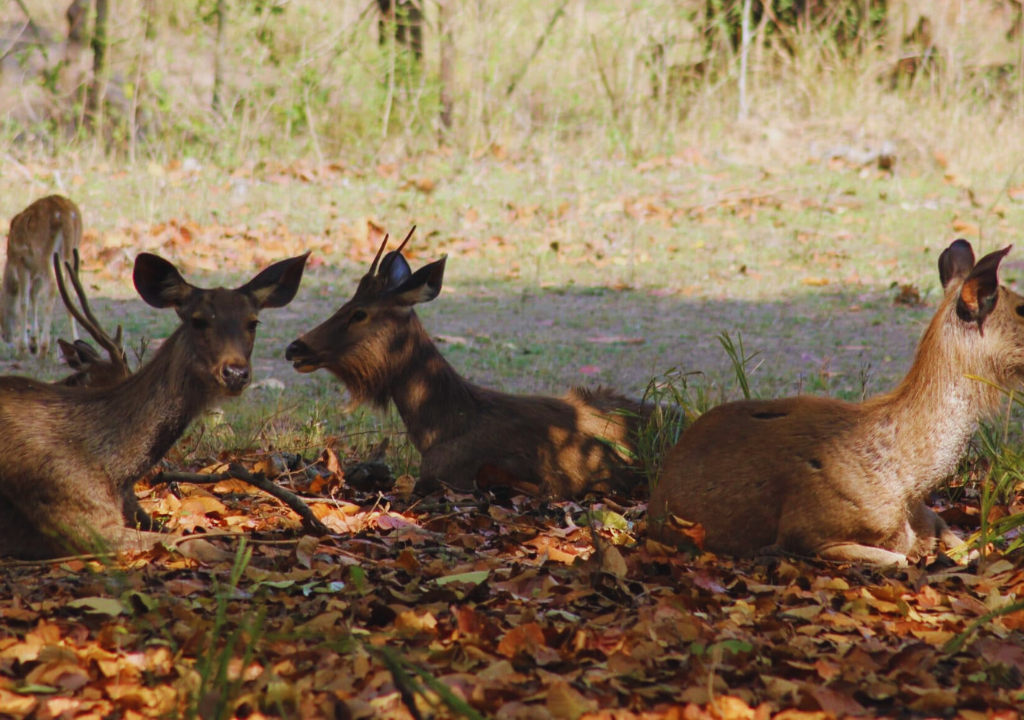In the heart of Rajaji National Park’s wilderness, where the rustling leaves compose a symphony and sunlight dances through the trees, a majestic creature roams—the sambar deer. Graceful and regal, the sambar holds a special place in the intricate tapestry of this natural sanctuary.
Nestled at the foothills of the Himalayas, Rajaji National Park stands as a testament to the splendor of nature’s creations. This sprawling expanse of biodiversity spans across the states of Uttarakhand and Uttar Pradesh in India, offering a haven for diverse flora and fauna. Among the charismatic inhabitants of the park, the sambar deer stands out as a symbol of beauty and vitality.
Sambar Deer Species: Majestic Denizens of the Forest
The sambar deer (Rusa unicolor) reigns as one of the largest deer species, boasting a magnificent presence that commands attention. Recognizable by its dark coat and distinctive antlers, the sambar is a sight to behold. Its stature and unique characteristics distinguish it from other deer species, rendering it a regal denizen of the forest.

Sambar Habitat and Distribution: Navigating Varied Landscapes
Within the mosaic of Rajaji’s landscapes, the sambar finds its preferred habitats. From dense forests to open grasslands, these versatile creatures adapt to a variety of ecosystems. Their presence graces the park’s diverse regions, offering observers a glimpse into their ability to navigate different environments with ease.
Sambar Behavior: Insights into their Lifestyle
Sambar deer are primarily nocturnal, using the cover of night to forage and move about. This adaptation allows them to avoid daytime heat and reduce their exposure to predators. Within the social structure of sambar herds, a matriarchal hierarchy often prevails. Communication occurs through vocalizations and body language, facilitating cohesion within the group.

Diet and Feeding Habits: The Culinary Preferences of Sambar
The sambar’s diet is as diverse as the landscapes it inhabits. These herbivores are opportunistic feeders, consuming a range of vegetation from grasses and shrubs to leaves and fruits. This dietary diversity has a profound impact on the ecosystem, influencing the composition of plant species and shaping the very landscape they call home.
Predator-Prey Dynamics: Balancing Act in the Wild
As a crucial prey species, the sambar’s role extends beyond its aesthetic presence. Its interactions with predators, such as tigers and leopards, contribute to the intricate dance of predator-prey dynamics. The survival of the sambar is intertwined with the health of the ecosystem, showcasing the delicate balance that sustains life in the wild.
Conservation Status: Preserving the Sambar Population
Understanding the conservation status of the sambar deer is pivotal to its protection. While not currently classified as endangered, the sambar’s population faces challenges due to habitat loss, poaching, and human disturbances. Rajaji National Park’s status as a protected area plays a vital role in providing a safe haven for these majestic creatures.
Threats to Sambar Deer: Addressing Challenges
The sambar deer’s existence is threatened by a myriad of challenges. Habitat loss due to urbanization and deforestation disrupts their natural habitats, leaving them vulnerable. Additionally, poaching for meat and body parts poses a serious risk to their survival. The park’s conservation efforts must address these threats to ensure the sambar’s continued presence.
Human Interaction and Coexistence: Sharing Spaces
As human settlements expand, encounters between humans and sambar become more common. These interactions can lead to conflicts, especially when sambar venture into human areas in search of food or water. Educating local communities about responsible behavior and implementing strategies for peaceful coexistence is essential.
Role of Sambar in Ecosystems: Beyond Beauty
The sambar’s role extends beyond its physical presence. These creatures contribute to the ecosystem’s balance through their feeding habits, selective browsing, and seed dispersal. By shaping the composition of plant species, they influence the overall health and diversity of the forest, highlighting their crucial ecological significance.
Conservation Initiatives: Safeguarding Sambar
Preserving sambar populations requires a multi-pronged approach. Protected areas like Rajaji National Park provide a sanctuary where these creatures can thrive. Additionally, the establishment of wildlife corridors and engaging local communities in conservation efforts fosters a collaborative approach to safeguarding the sambar’s future.
Eco-Tourism and Sambar Encounters: Ethical Observations
Eco-tourism offers a unique opportunity to observe sambar deer in their natural habitat. Responsible practices ensure that the animals are not unduly stressed or disrupted. Maintaining a respectful distance and refraining from feeding them are essential to the well-being of the sambar and the preservation of their natural behaviors.
Sambar Symbolism: Cultural and Ecological Significance
Beyond their ecological role, sambar deer hold cultural and spiritual significance in many societies. They are often revered in indigenous cultures and considered symbols of beauty and vitality. The presence of sambar in the forest serves as an indicator of its health, highlighting the interplay between nature and culture.

Tracking Sambar: Insights from Research and Monitoring
Scientific research provides valuable insights into sambar behavior, movements, and population dynamics. Monitoring methods such as camera traps and tracking studies contribute to our understanding of their habits and habitat preferences. This knowledge informs conservation strategies and ensures informed decision-making.
Local Engagement: Communities as Guardians of Sambar
Local communities play a pivotal role in the conservation of sambar deer. Involving communities in conservation initiatives fosters a sense of ownership and responsibility. By raising awareness, providing education, and involving locals in monitoring efforts, a collective effort is forged to protect the sambar and its habitat.
Conclusion
In the heart of Rajaji National Park’s sprawling wilderness, the sambar deer stands as a testament to the park’s rich biodiversity and ecological significance. Their majestic presence, along with their role in shaping the landscape and supporting the ecosystem, underscores the delicate balance that sustains life. As custodians of the wild, it’s our collective responsibility to ensure that the sambar’s legacy continues to grace the forest for generations to come.
FAQs About Sambar in Rajaji National Park
Are sambar deer dangerous to humans?
Sambar deer are generally shy and not considered dangerous to humans. However, like all wild animals, they should be observed from a safe distance to avoid any potential conflicts.
Can I spot sambar deer during daytime safaris?
While sambar are primarily active during the early morning and late evening, sightings during daytime safaris are possible. Their nocturnal behavior may lead to more frequent sightings during these times.
Do sambar deer play a role in forest regeneration?
Yes, sambar deer play a vital role in shaping the landscape through their feeding habits and selective browsing. They contribute to plant diversity and forest regeneration by dispersing seeds as they move through different habitats.
How can I contribute to sambar conservation in Rajaji National Park?
Supporting eco-friendly tourism, respecting park regulations, and spreading awareness about the importance of sambar conservation are all meaningful ways to contribute.
What is the significance of sambar deer in indigenous cultures?
In many indigenous cultures, sambar deer hold cultural and spiritual significance, often symbolizing beauty, vitality, and the interconnectedness of humans and nature.
